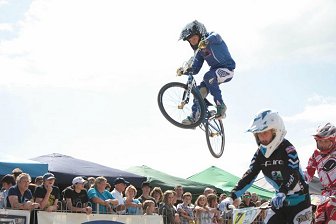BMX & Health
Health and Young People
What the Evidence Tells Us
-
 Need to increase the percentage of people who take moderate physical activity for a total of 30 minutes on 5 or more days of the week. Need to increase the percentage of people who take moderate physical activity for a total of 30 minutes on 5 or more days of the week.
- Objectives include increasing the provision and uptake of physical activity that is accessible and affordable to the population as a whole, addressing inequalities in the access to leisure and to promote activity that can be built into everyday life.
- It is also recommended that all young people should participate in physical activity of at least moderate intensity for one hour a day.
- Children are getting fatter despite eating less because levels of physical activity have decreased.
- When planning interventions it is important to look at the barriers to participation that young people might experience.
- Reducing inequalities also meets the aim of Local Agenda 21 to include local people in the development of social, economic and environmental sustainability.
- Evidence suggests that activities at or in the vicinity of the home are most effective.
- For young people physical activity opportunities outside school need to be accessible and seen as safe.
- Young people need to be involved in the decision making process.
- Interventions should also be relevant to age, gender and location.
Formal V's Informal
The Somerset Physical Activity Group 1997 strategy focuses on promoting activity within school time and does not address physical activity out of school. This is despite recognition that young people are less active at the weekend compared to a school day.
There are pointers for alternative focus for the programmes. This includes mention of school leavers for whom 'access to community leisure provision becomes increasingly more important' and 'building activity into everyday life at a young age is important in establishing enjoyment of activity'.
This seems to suggest that there is a need for programme's that:
- Improve access to community leisure facilities.
- Provide opportunities out of school during the weekend, evening and holidays.
Getting Young People Active
I would argue that:
-
 If we want to get more young people to be more active more often we consider the following questions. What is stopping young people from being more active? What competes against physical activity for their time? What choices do they make and why? If we want to get more young people to be more active more often we consider the following questions. What is stopping young people from being more active? What competes against physical activity for their time? What choices do they make and why?
- Compared to previous generations the young people of today have a greater choice with regards to the range activities they can do in their spare time.
- There are a larger number of sedentary activities available to young people, such as computers, game consoles and Sky TV.
- Large sums of money are spent by the companies concerned promoting these sedentary activities to young people.
- Physical activities are battling against sedentary activities for young people's time and (generally speaking) loosing.
- We know that young people can experience a number of barriers (transportation, time constraints and cost) to accessing the physical activity opportunities that are available.
- Popular sedentary activities don't have the same number of barriers (initial cost of the computer).
- For a young person it is easier to stay at home and play on the computer than it is for them to go to the local sports centre. It is also probably more fun than going down to the local recreation ground that doesn't really cater for their needs.
- In order to get more young people more active more often the opportunities available involving physical activity need to be more attractive than those opportunities available involving sedentary activity.
- To do this they need to meet the specific needs of the young people and overcome the barriers that stop them from accessing them.
Conclusion
A balanced approach to providing formal and informal opportunities is important. We need consider appropriate informal recreation facilities for young people in their immediate community as well as more formal opportunities at school etc.
Tim Huxley
Sport and Leisure Officer (North)
South Somerset District Council |
Copyright Tim Huxley © 2002
|
|